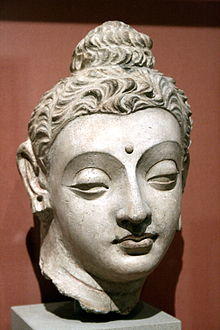| Translations of Urna | |
|---|---|
| Sanskrit | ऊर्णा (IAST: ūrṇā) |
| Pali | उण्ण (uṇṇa) |
| Chinese | 白毫 (Pinyin: Báiháo) |
| Japanese | 白毫 (rōmaji: byakugō) |
| Korean | 백호 (RR: baekho) |
| Tibetan | མཛོད་སྦུས་ Wylie: mdzod spu |
| Vietnamese | Bạch mao tướng |
| Glossary of Buddhism | |
In Buddhist art and culture, the Urna (more correctly ūrṇā or ūrṇākośa[1] (Pāli uṇṇa), and known as byakugō (白毫) in Japan) is a spiral or circular dot placed on the forehead of Buddhist images as an auspicious mark.[1][2] It symbolizes a third eye, which in turn symbolizes vision into the divine world; a sort of ability to see past our mundane universe of suffering.
As set out in the Lakkhana Sutta or 'Discourse on Marks', the ūrṇā is the thirty-first physical characteristic of Buddha.[3] It is generally thought to be a whorl of hair and be a mark or sign of the Buddha as a mahāpuruṣa or great being. The device is often seen on sculptures from the 2nd century CE.
See also
References
- ^ a b "The Lost Buddhas: Chinese Buddhist Sculpture from Qingzhou". Asian Art. April 14, 2012. Archived from the original on June 24, 2015. Retrieved April 12, 2016.
- ^ Stratton, Carol (2004). Buddhist Sculpture of Northern Thailand. Serindia Publications. p. 50. ISBN 9781932476095.
- ^ Holt, John Clifford; Kinnard, Jacob N.; Walters, Jonathan S. (2012). Constituting Communities: Theravada Buddhism and the Religious Cultures of South and Southeast Asia. SUNY Press. p. 191. ISBN 9780791487051.
